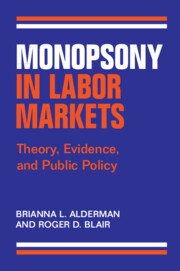Book contents
- Monopsony in Labor Markets
- Monopsony in Labor Markets
- Copyright page
- Dedication
- Contents
- Figures
- Tables
- Preface
- Acknowledgments
- 1 Monopsony in the Labor Market
- 2 The Economics of Monopsony
- 3 Empirical Evidence of Monopsony in Labor Markets
- 4 Antitrust Policy in the United States
- 5 The Intended and Unintended Victims of Monopsony
- 6 Collusion on Wages and Terms of Employment
- 7 No-Poaching Agreements
- 8 Noncompete Agreements
- 9 Unions and Collective Bargaining
- 10 Monopsony and Merger Policy
- 11 Closing Thoughts
- Index
3 - Empirical Evidence of Monopsony in Labor Markets
Published online by Cambridge University Press: 08 February 2024
- Monopsony in Labor Markets
- Monopsony in Labor Markets
- Copyright page
- Dedication
- Contents
- Figures
- Tables
- Preface
- Acknowledgments
- 1 Monopsony in the Labor Market
- 2 The Economics of Monopsony
- 3 Empirical Evidence of Monopsony in Labor Markets
- 4 Antitrust Policy in the United States
- 5 The Intended and Unintended Victims of Monopsony
- 6 Collusion on Wages and Terms of Employment
- 7 No-Poaching Agreements
- 8 Noncompete Agreements
- 9 Unions and Collective Bargaining
- 10 Monopsony and Merger Policy
- 11 Closing Thoughts
- Index
Summary
We provide an overview of the empirical results with ample references to the literature. There is a substantial body of research that establishes the pervasive presence of monopsony in labor markets. The root cause of monopsony power lies in the fact that labor markets are imperfect. In other words, labor supply functions are positively sloped, which allows the dominant employers to depress compensation by reducing employment. Moreover, there are various frictions that reduce an employee’s ability to respond to alternative employment opportunities. These include costs of job search, turnover, and mobility barriers.
- Type
- Chapter
- Information
- Monopsony in Labor MarketsTheory, Evidence, and Public Policy, pp. 32 - 49Publisher: Cambridge University PressPrint publication year: 2024

